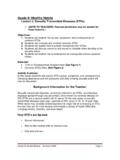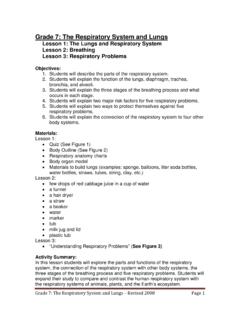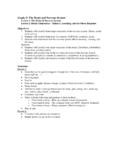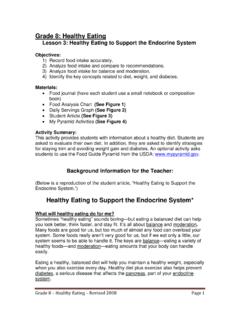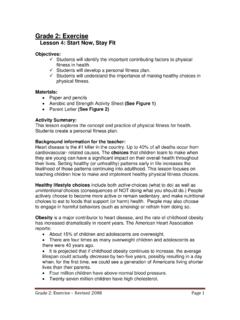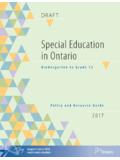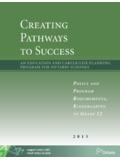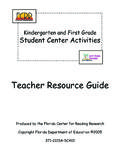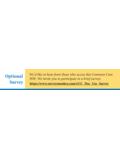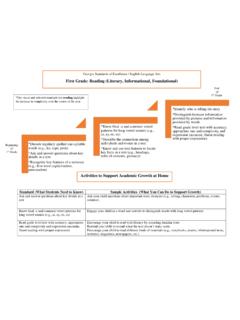Transcription of Grade: Kindergarten – Self-Esteem Lesson 8: I Am …
1 grade : Kindergarten self esteem Revised 2008 Page 1 grade : Kindergarten Self-Esteem Lesson 8: I Am Glad I Am Me Objectives: 9 Students will identify things they are good at doing. 9 Students will identify talents of others. 9 Students will identify ways to encourage themselves and others to be the best they can be. Materials: Posterboard, washable colored markers, glue, scissors Photograph of each child (Have each child bring a photograph of him/herself from home OR photograph the child digitally yourself. If the children bring photos from home, scan or photocopy the originals so they can be returned home intact.) Vocabulary Book pages (See Figure ) Children s Literature: I Like Me by Nancy Carlson Helping Children to Build self esteem : A Photocopiable Activities Book by Deborah Plummer Activity Summary: In this Lesson students will explore the ways they and others are special, and the importance of encouraging ourselves and others to develop our talents.
2 Background information for the teacher: Not necessary at this level of instruction. Vocabulary: Talent something we are good at doing Feelings what we experience when we are happy, sad, mad, proud, etc. Encouragement a way of helping someone Engage (10 minutes): Read a story that helps children understand that we each have wonderful and different talents. This could be an abbreviated version of The Ugly Duckling or a more contemporary story that illustrates the main points of this Lesson . Use the story as a discussion tool. Then have the students close their eyes and think about what they are good at doing. Have each student get a partner and tell their partner what they are good at doing.
3 Explore: 20-25 minutes (This activity can also be broken into two shorter segments.) grade : Kindergarten self esteem Revised 2008 Page 2 Write I AM GLAD I AM ME on the board. Give each student a posterboard, gluestick, scissors and colored markers, along with their photograph. Next, have each child print his/her name across the top of the posterboard, then paste their photo below their name in the center of the poster. Next, direct the children to draw self -portraits around their photograph, illustrating things they like to do and are good at doing. When they are finished, have the children sit in a circle and tell the story about their self -portrait and what they like to do.
4 Encourage the students to start their story by saying I am glad I am me because .. After each child shares their talents, ask the other students to share something they liked about what that child just shared. Explain: (15 minutes) Ask: What is a talent? (Allow children to respond.) Talents are things we are good at doing. (Acknowledge students for the many different things they like to do and are good at doing.) We call ALL of these wonderful things TALENTS. Talents are things we are GOOD at doing. While children are still sitting in a circle, have each child hold their poster in front of them. Then ask them to look carefully at everyone else s posters.
5 Ask: What are some of the talents that you notice OTHER children have? (Use their responses to point out to them that there are MANY KINDS of TALENTS: artistic, athletic, musical, etc. Some children are talented at being good friends, sisters or brothers, while other children are good with their pets, or growing flowers and other plants.) Ask: What other talents do you have? (Write each answer, then explore the idea that a child can have many different kinds of talents.) Ask: What do you like about your talents? How do your talents make you think about yourself? (Possible answers: proud, happy, etc.) Tell the students these are called feelings.
6 A feeling is a way we are when we are happy, sad, laughing, etc. There are many different kinds of feelings. We can feel good and happy about our talents AND we can feel good and happy when we see OTHER people being good at what they are doing. We encourage others when we do this. We can use our feelings about our talents to feel good about ourselves and to help others feel good about themselves, too. Ask the students to turn to the child next to them and say one thing they like about that student s poster, then ask: What are some ways we can encourage others? Ourselves? grade : Kindergarten self esteem Revised 2008 Page 3 Encouragement is an important way we can help ourselves and other people feel glad WE ARE WHO WE ARE.
7 Ask: Are YOU glad to be you? EVERYBODY GIVE A BIG CHEER! Extend: Vocabulary Picture Book (NOTE: This connects with the Extend activities which were begun in the Body Systems Lesson and continue through all the Kindergarten lessons.) Give each child the pages for each of the following vocabulary words: TALENTS, FEELINGS, and ENCOURAGEMENT, along with the page entitled MY TALENTS. For each vocabulary word, have the child do a drawing or paste a picture from a magazine or newspaper. Have the children take the My Talents page and have their parents/caregivers list THREE things the child does well and sign it. The child will bring the signed page back to school and include it in the Vocabulary Picture Book.
8 Each page should be three-hole punched. When the Vocabulary Book is completed for all the unit lessons, it can be assembled by tying yarn or colored ribbon through the holes. Evaluate: Use the Vocabulary Picture Book as an assessment tool. Additional Web Resources: Health and Physical Education: Frameworks 1. Functions and interrelations of systems B. Social Systems What all students should know: 2. Family, friends, and peers can have a positive or negative influence on their well-being. What all students should be able to do: Describe characteristics needed to be a responsible friend or family member. What all students should know: 5.
9 A component of effective communication is the ability to express needs, wants and feelings in health-enhancing ways. What all students should be able to do: c. Demonstrate ways to communicate care, consideration and respect of self and others. TalentsFeelingsMy talentsisgood
